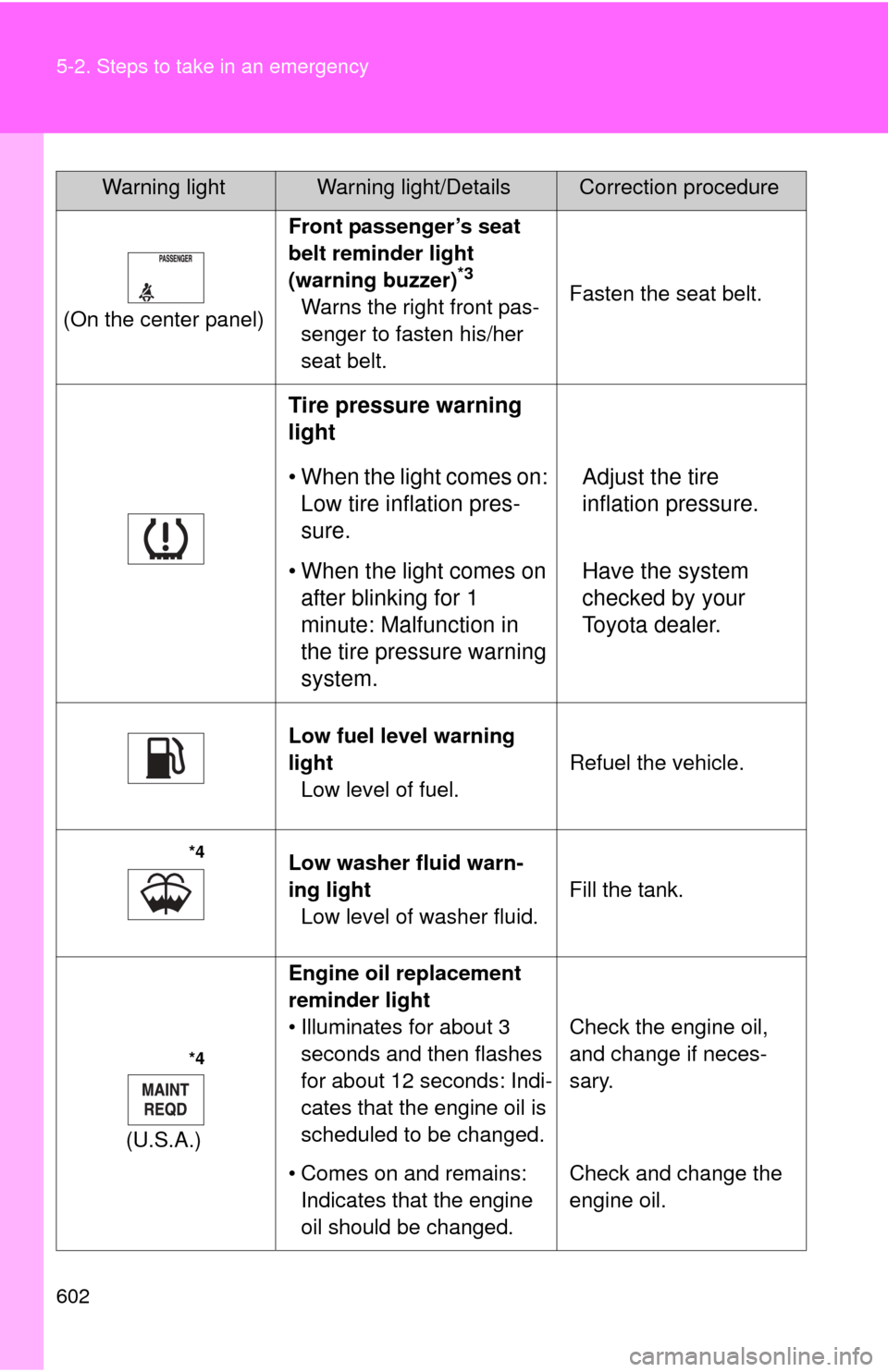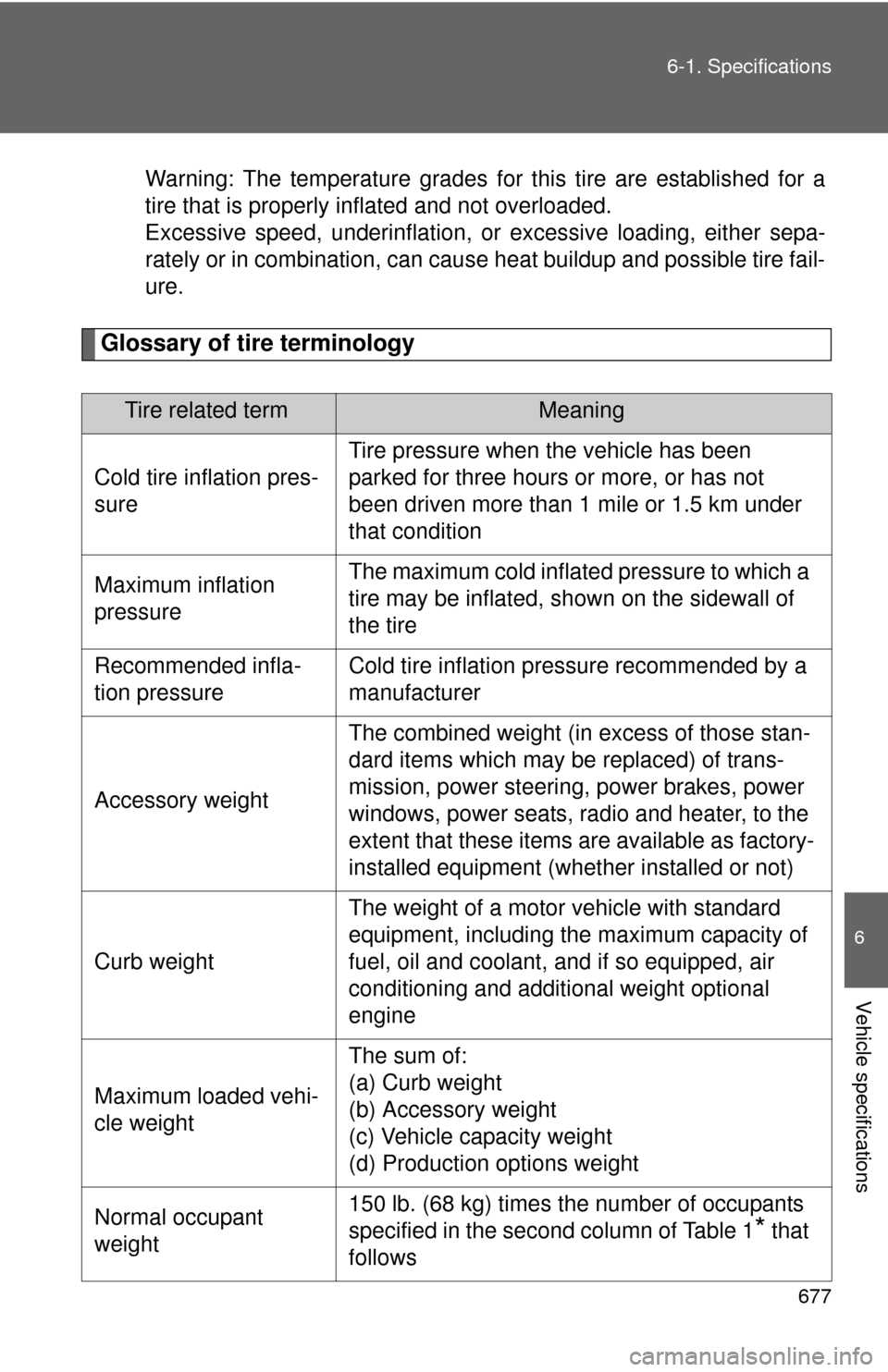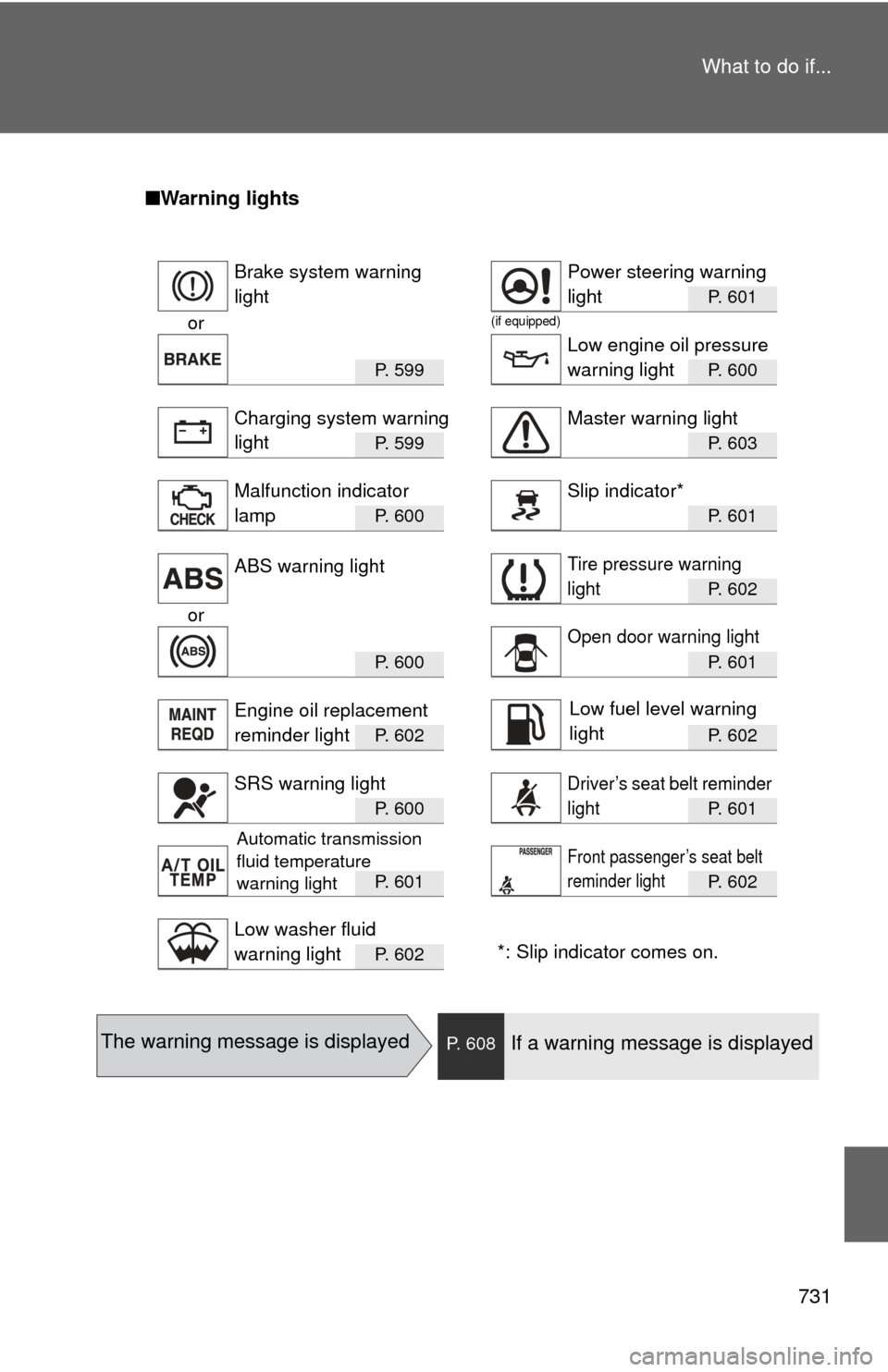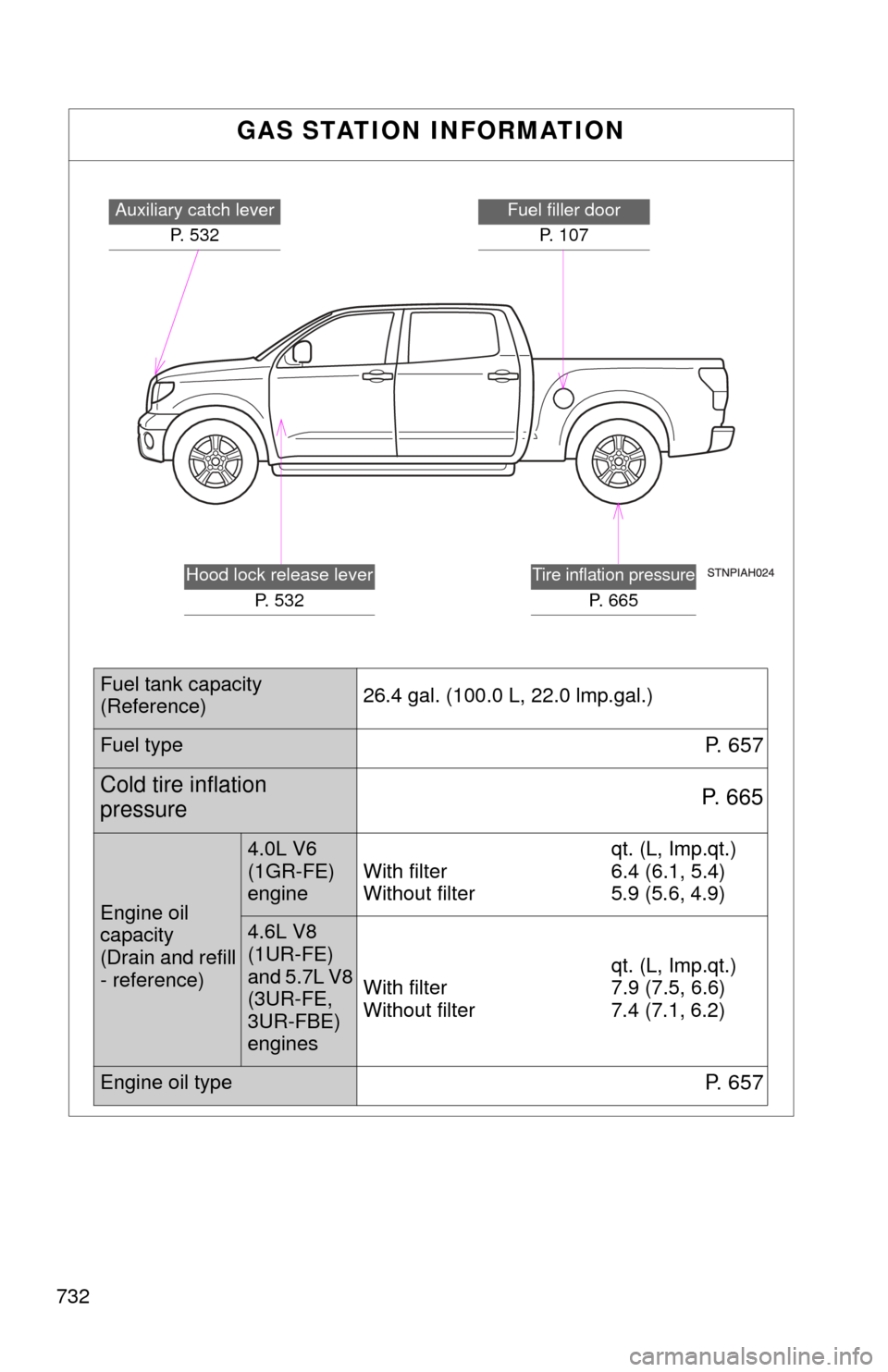2011 TOYOTA TUNDRA fuel pressure
[x] Cancel search: fuel pressurePage 602 of 732

602 5-2. Steps to take in an emergency
(On the center panel)Front passenger’s seat
belt reminder light
(warning buzzer)
*3
Warns the right front pas-
senger to fasten his/her
seat belt.
Fasten the seat belt.
Tire pressure warning
light
• When the light comes on:
Low tire inflation pres-
sure. Adjust the tire
inflation pressure.
• When the light comes on after blinking for 1
minute: Malfunction in
the tire pressure warning
system. Have the system
checked by your
Toyota dealer.
Low fuel level warning
light
Low level of fuel. Refuel the vehicle.
*4Low washer fluid warn-
ing light
Low level of washer fluid. Fill the tank.
*4
(U.S.A.)Engine oil replacement
reminder light
• Illuminates for about 3
seconds and then flashes
for about 12 seconds: Indi-
cates that the engine oil is
scheduled to be changed. Check the engine oil,
and change if neces-
sary.
• Comes on and remains: Indicates that the engine
oil should be changed. Check and change the
engine oil.
Warning lightWarning light/DetailsCorrection procedure
Page 604 of 732

604 5-2. Steps to take in an emergency
■Open moon roof reminder buzzer
The buzzer indicate that the moon roof is still opened (with the engine switch
in the ACC or LOCK position and the driver’s door opened).
■ If the malfunction indicator lamp comes on while driving
First check the following:
● Is your vehicle low on gas?
If it is, refuel the vehicle immediately.
● Is the fuel tank cap loose?
If it is, tighten it securely.
The light will go off after taking several driving trips.
If the light does not go off even after several trips, contact your Toyota dealer
as soon as possible.
■ Front passenger detect ion sensor and passenger seat belt reminder
If luggage or other load is placed on the right front passenger seat, depend-
ing on its weight, the reminder light to flash and buzzer to sound.
■
When the tire pressure warning light comes on
Check the tire inflation pressure and adjust to the appropriate level.
Pushing the tire pressure warning reset switch does not turn off the tire
pressure warning light.
■The tire pressure warning light ma y turn on due to natural causes
The tire pressure warning light may turn on due to natural causes such
as natural air leaks or tire inflation pressure changes caused by temper-
ature. In this case, adjusting the ti re inflation pressure will turn off the
warning light (after several minutes).
■When a tire is replaced with a spare tire
The temporary spare tire is not equipped with the tire pressure warning
valve and transmitter. If a tire goes flat, the tire pressure warning light will
not turn off even though the flat tire is replaced with the temporary spare
tire. Replace the temporary spare tire with the repaired tire and adjust
the proper tire inflatio n pressure. The tire pres sure warning light will turn
off after several minutes.
Page 606 of 732

606 5-2. Steps to take in an emergency
CAUTION
■If the tire pressure warning light comes on
Be sure to observe the following precautions. Failure to do so could
cause loss of vehicle control and re sult in death or serious injury.
●Stop your vehicle in a safe place as soon as possible. Adjust the tire
inflation pressure immediately.
●If the tire pressure warning light comes on even after tire inflation pres-
sure adjustment, it is pr obable that you have a flat tire. Check the tires.
If the tire is flat, change to the spare tire and have the flat tire repaired
by the nearest Toyota dealer.
●Avoid abrupt maneuvering and braking. If the vehicle tires deteriorate,
you could lose control of the steering wheel or the brakes.
■If a blowout or sudden air leakage should occur
The tire pressure warning syste m may not activate immediately.
■Maintenance of the tire
Each tire, including the spare (if provided), should be checked monthly
when cold and inflated to the inflation pressure recommended by the
vehicle manufacturer on the vehicle placard or tire inflation pressure
label (tire and load information label). (If your vehicle has tires of a differ-
ent size than the size indicated on the vehicle placard or tire inflation
pressure label [tire and load information label], you should determine the
proper tire inflation pr essure for those tires.)
As an added safety feature, your vehicle has been equipped with a tire
pressure monitoring system (TPMS-ti re pressure warning system) that
illuminates a low tire pressure telltal e (tire pressure warning light) when
one or more of your tires is significantly under-inflated. Accordingly,
when the low tire pressu re telltale (tire pressure warning light) illumi-
nates, you should stop and check your tires as soon as possible, and
inflate them to the proper pressure. Driving on a significantly under-
inflated tire causes the tire to overheat and can lead to tire failure.
Under-inflation also reduces fuel effi ciency and tire tread life, and may
affect the vehicle’s handling and stopping ability.
Page 677 of 732

677
6-1. Specifications
6
Vehicle specifications
Warning: The temperature grades for this tire are established for a
tire that is properly inflated and not overloaded.
Excessive speed, underinflation, or
excessive loading, either sepa-
rately or in combination, can caus e heat buildup and possible tire fail-
ure.
Glossary of tire terminology
Tire related termMeaning
Cold tire inflation pres-
sure
Tire pressure when the vehicle has been
parked for three hours or more, or has not
been driven more than 1 mile or 1.5 km under
that condition
Maximum inflation
pressureThe maximum cold inflated pressure to which a
tire may be inflated, s hown on the sidewall of
the tire
Recommended infla-
tion pressureCold tire inflation pressure recommended by a
manufacturer
Accessory weight
The combined weight (in excess of those stan-
dard items which may be replaced) of trans-
mission, power steering, power brakes, power
windows, power seats, radio and heater, to the
extent that these items are available as factory-
installed equipment (whether installed or not)
Curb weight
The weight of a motor vehicle with standard
equipment, including the maximum capacity of
fuel, oil and coolant, and if so equipped, air
conditioning and additional weight optional
engine
Maximum loaded vehi-
cle weight
The sum of:
(a) Curb weight
(b) Accessory weight
(c) Vehicle capacity weight
(d) Production options weight
Normal occupant
weight150 lb. (68 kg) times the number of occupants
specified in the second column of Table 1
* that
follows
Page 727 of 732

727
Alphabetical index
Four-wheel drive system
warning buzzer................... 603
Driver’s seat belt................... 601
Front passenger occupant classification system .......... 600
Front passenger’s seat belt ............................. 601
Low brake fluid ..................... 599
Low engine oil pressure ....... 599
Low fuel level................ 601, 609
Low tire inflation
pressure ............................. 601
Malfunction indicator lamp.... 600
Master warning light ............. 601
Open door ............................ 601
Power steering warning light .................................... 600
Pretensioners ....................... 600
Seat belt reminder light ........ 601
SRS airbags ......................... 600
Tire pressure warning light ... 601
VSC/TRAC ........................... 600
Warning messages ................. 608
Washer
Checking .............................. 545
Preparing and checking before winter ...................... 261
Switch ................................... 217
Washing and waxing............... 516
Weight
Cargo capacity ..................... 259
Cargo weight rating .............. 708
Gross axle weight rating ....... 712
Gross vehicle weight rating .................................. 712
Load limits ............................ 259
Towing capacity.................... 651
Trialer Weight Rating.... 267, 651
TWR ............................. 267, 651
Vehicle capacity weight ........ 648
Weight .......... 648, 651, 708, 712
Wheels...................................... 558
Window glasses ........... 94, 98, 99 Window lock switch ...................96
Windows
Back window defogger ..........311
Power back window ................99
Power windows .......................94
Washer ..................................217
Windshield wiper de-icer .............................309, 311
Windshield wipers ...................217
Wireless remote control Replacing the battery ............563
Wireless remote control ..........44
Winter driving tips ...................261
WMA disc ..................................335
Page 731 of 732

731
What to do if...
■
Warning lights
P. 601
or(if equipped)
P. 599 P. 600
P. 599 P. 603
P. 600 P. 601
P. 602
or
P. 6 0 0P. 601
P. 6 0 2P. 602
P. 6 0 0P. 601
P. 6 0 1P. 602
*: Slip indicator comes on.P. 6 0 2
Brake system warning
lightPower steering warning
light
Low engine oil pressure
warning light
Charging system warning
lightMaster warning light
Malfunction indicator
lampSlip indicator*
ABS warning lightTire pressure warning
light
Open door warning light
Engine oil replacement
reminder lightLow fuel level warning
light
SRS warning lightDriver’s seat belt reminder
light
Front passenger’s seat belt
reminder light
Low washer fluid
warning light
Automatic transmission
fluid temperature
warning light
The warning message is displayedP. 608If a warning message is displayed
Page 732 of 732

732
GAS STATION INFORMATION
Auxiliary catch leverP. 532Fuel filler doorP. 1 0 7
Tire inflation pressure
P. 665
Hood lock release lever P. 532
Fuel tank capacity
(Reference) 26.4 gal. (100.0
L, 22.0 lmp.gal.)
Fuel typeP. 657
Cold tire inflation
pressure P. 6 6 5
Engine oil
capacity
(Drain and refill
- reference)
4.0L V6
(1GR-FE)
engineqt. (L, Imp.qt.)
With filter 6.4 (6.1, 5.4)
Without filter 5.9 (5.6, 4.9)
4.6L V8
(1UR-FE)
and 5.7L V8
(3UR-FE,
3UR-FBE)
engines qt. (L, Imp.qt.)
With filter 7.9 (7.5, 6.6)
Without filter 7.4 (7.1, 6.2)
Engine oil typeP. 657